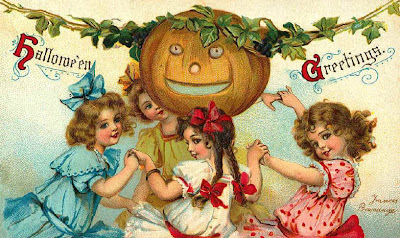 |
| Buddhist Halloween? |
Should Buddhists celebrate the ancient
Celtic Druid festival of Halloween?
What's the connection between this
pre-Christian Druid festival and Buddhism?

Buddhism teaches that the mind is
not a physical entity.
Consequently,
physical factors can neither create nor destroy it.

The mind exists before conception, and survives after death to be reborn into another body.
The Druids were ancient Celtic priests who shared the Buddhists' belief in
rebirth and the indestructibility of the mind.

They regarded the seasons of the year as being a metaphor for the death and rebirth of the human being.
Halloween represented the death of the old year and was believed to be the time of year when the veil separating the human and ghost realms was at its thinnest.
 Yule (the winter solstice)
Yule (the winter solstice) was the time of conception of the coming year and
Imbolc (Candlemas) was the actual birth of the New Year, with the appearance of the first lambs and green shoots.
The period between Yule and
Candlemas was the gestational period when the new animal and plant life, though growing and stirring, was still hidden in the body of its mother, or in the case of vegetation within the body of mother earth.

The significance of Halloween to Buddhists now becomes clear. In the Druid system the period of seven weeks between Halloween and Yule is the gap between death of the old and conception of the new year. This corresponds to the 49 days of the
bardo.
Halloween thus symbolises the entry of the disembodied consciousness into the intermediate state between leaving one body and occupying another.
In traditional Buddhist beliefs the
bardo-consciousness will experience hideous apparitions - ghosts, demons etc.

If the mind reacts with panic then a
samsaric rebirth, possibly in unpleasant realms, is inevitable.
However if the
bardo-being recognises these
apparitions as hallucinations - projections and reflections of its own negative karma resulting from evil actions - then liberation remains possible.

The reasons for the
Druidic custom of dressing up as ghosts, demons and so on may be to symbolise that these scary
bardo apparitions are in fact nothing other than aspects or appearances of the person's own self.
In tantra,
gruesome visualizations are used to purify negativities

Among Western Buddhists, the festival of
Samayatara, the female Buddha of the Northern direction associated with midnight and the wisdom of action,
is commemorated at Halloween.

"...The point here being, of course, that as Buddhism has moved into new
cultural spaces it has adopted the forms of those cultures, using them
to express peculiarly Buddhist themes and sometimes supplanting their
original meanings entirely [1]. Naturally, as Buddhism becomes rooted
in the West we should expect the same treatment to be applied to Western
cultural forms, even though by all accounts it appears to be appalling
to many culturally conservative Buddhists that Westerners should want to
practice and celebrate Buddhadharma in ways that resonate for their own
cultures. But, speaking for myself, I see this as a good thing - I am not Tibetan/Japanese/Chinese/Thai/etc. and I do not wish to be [2].
Which brings me to an upcoming and super-fun holiday: Halloween [3]! If
there is any holiday that I want/is a good candidate for
being Buddhized, this is it. There are several reasons why this is so:
- Although the broad outlines of the origins and meaning of Halloween
are known, they are not believed in. The holiday is widely celebrated
by Western (at least, North American) society, but is largely devoid of
meaning. Indeed, the actual meaning of “trick or treat” never
occurred to me until I was an adult – it had always just been a phrase
that got you candy (which was good enough).
- More specifically, Halloween has no Christian content,
which makes Buddhization much easier for two reasons. First and most
importantly, to Buddhize Halloween will not cause outrage among/backlash
from the Christian community. Secondly, there’s no metaphysics that
will need abandonment or difficult reworking in order to fit with
Buddhist thought.
- The West needs to take the dark side of life more seriously.
- There are tantalizing hints of existing traditions that could, by
mere suggestion, be transformed from simple fun into meaningful ritual.
- It’s so so so fun.
I can think of a few obvious ways this could be done:
- Teachings about hungry ghosts/hell realms.
- Pointing out the emptiness of ‘external’ perceptions (what’s behind the mask?).
- Transforming emotional reactions, demonstrating purity of the world
(the old peeled grapes as eyeballs, spaghetti as brains, etc.).
- Chod practice!
- Death and rebirth teachings/meditations."
 |
| Dr Yutang Lin blessing a ghost to leave a haunted house and be reborn in the Pure Land |
Giving of fearlessness - bringing peace to haunted houses
 Festival of the Hungry Ghosts
Festival of the Hungry Ghosts
 The Halloween Monk
The Halloween Monk
 Halloween Asian Style
Halloween Asian Style
 Halloween and World Religions
Halloween and World Religions

 Thai Halloween Party May End
Thai Halloween Party May End



















